September 27th, 2010 ~ by admin
Wired has an interesting article about several prototypes of rather historical devices. Of much interest are the Apple 1, and the Atari 2600 although the doorbell powered Moog is pretty classy as well.
Take a look at the Atari 2600 prototype and notice that they used a MOS 6502 in it. The final version used the lower cost (and smaller) MOS (or Synertek) 6507.
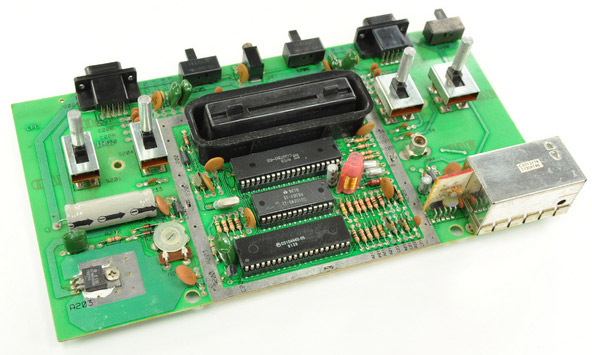
Atari 2600 Motherboard - 6507 CPU
When designing a product, it often is easier to use the standard full featured version of an IC for development work, and then as you refine the design, trim down to the least, and smallest components you can.
We also learn how Foxconn got its idea of low wages. Steve Jobs himself paid his sister a mere $1/board to assemble the Apple 1.
Its interesting to see how prototypes can be so vastly different from the finished product. A fact that design engineers know all to well. “I have to put all of THAT into what?”
September 23rd, 2010 ~ by admin
In the beginning there was the microprocessor. A collection of logic that centered around an ALU (Arithmetic and Logic Unit) and a series of registers. It was capable of doing most tasks just fine. Simple math, and boolean logic were the key to most programming needs. As the life of the processor and its extension, the microcontroller, progressed the computing needs became larger. Programmers wanted to be able to manipulate larger numbers, and floating point ones at that. Add and Subtract were no longer sufficient, division, multiplication and a host of other mathematical functions were needed. In the 1970’s transistor counts were in the thousands, frequency in the MHz and line widths were measured in microns. It was not feasible to build these math functions, in hardware, on the same chip (or rather die) as the processor.
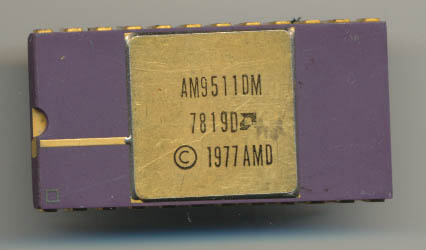
AMD AM9511DM – 2MHz Military Temp Range APU – 1978
Several companies worked to solve this. Perhaps the most successful, and famous, was AMD. AMD in 1977 introduced the AM9511 Arithmetic Processing Unit. It is best described as a scientific calculator on a chip. It could handle 32 bit double precision math (via 16 bit stack/registers) and supported not just the basic ADD, SUB, MUL and DIV, but SIN, COS, TAN, ASIN, ACOS, ATAN, LOG, LN, EXP, and PWR. 14 floating point instructions, in hardware, on a single chip. It ran at up to 3MHz (4MHz in the ‘A’ version) and could interface with pretty much any microprocessor or microcontroller, providing much needed processing power. It was designed as a peripheral, so that the main processor could assign it a task, and then go on about its program while the AM9511 crunched the math. The AM9511 would then notify the host processor via interrupt that it was finished the the data/status was ready to be read.
AMD updated the design to support……
Read More »
September 20th, 2010 ~ by admin
Here is an interesting project. Take very high resolution photography of a MOS 6502 die (such as that the powered the Apple 1) and use it to construct a simulater in Java that allows you to program the 6502 and watch it, on a transistor level, as it performs the program.
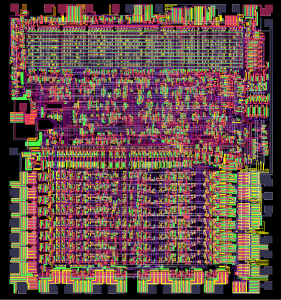
6502 Die - Visual 6502
An awesome way to see PHYSICALLY what happens for each and every instruction. And what a great processor to do so on. Ironically the LCD flat panel monitor you may be using? It may well be powered by a 6502 (Novatek used them in their flat panel controllers)
Check it out at Visual 6502
September 15th, 2010 ~ by admin
In 1976 the fasted normal processor ran at around 5MHz (such as the RCA 1802). Personal computers really hadn’t been thought of, and mainframes were massive. It was then that Seymour Cray decided to build a Super Computer. A computer that would be better and faster then most anything that existed at the time.
The Cray-1 ran at a blistering 80MHz, and could work with a staggering 32MB of memory. This performance was not achieved in personal computers until the 1990’s. No single processor of 1976 could attain these speeds so Cray designed his own. Only 4 different types of ICs were used in the Cray-1 (2 types of quad-NAND gates and 2 types of SRAM) All of the logic was ECL (Emitter Coupled Logic) which was very fast, very power hungry, and produced a lot of heat. In all the Cray-1 used some 200,000 gates, many of which were solely used to add timing delays to make sure signaling did not generate standing waves or switching noise.
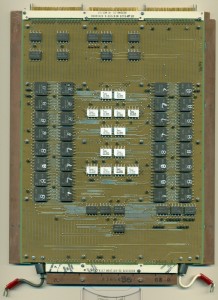
Original Cray-1 Circuit Board
Recently a man by the name of Chris Fenton decided to make a 1/10th WORKING scale model of the Cray-1A. This is no small feat, there is not a lot of surviving documentation for the Cray, nor is there much of any software left (they were mostly retired from service by 1990). Chris wished the Cray-1 to physically look like the Original (including the padded bench seat) as well as be binary code compatible. His implementation runs at 33MHz on a Xilinx Spartan-3E 1600 CPLD. Basically this is a dev board with a chip that has a complex array of programmable logic that you can program to do what you want. In this case 1.6 million gates, about 1.2 Million of which are used in the design, significantly more the the original.
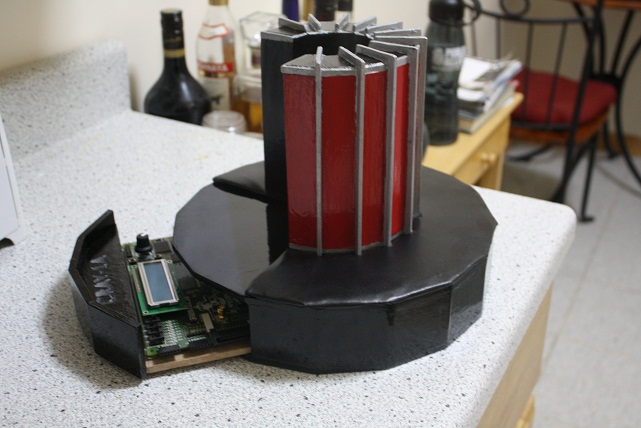
Cray-1A Model
The original Cray weighed in at 5.5 tons with the cooling system, and drew around 30kW of power. The 1/10th scale? will run on a few batteries. Supercomputers are still an important part of computing, but as vector processing expands (what the Cray was orginally diesgned for) such things as graphics cards can be used to perform much of the tasks of a supercomputer, and do so faster and cheaper.
Regardless, when people think of a Super Computer, they think of the Cray
September 13th, 2010 ~ by admin
We have previously talked about the issue of fake IC’s. The problem continues to get worse, and is making more and more press. Almost 10,000 incidents of fake ICs were recorded by the commerce department in the US in 2008 (the most recent stats available). Each ‘incident’ is usually several thousand IC’s. Over 2 million fake IC’s are seized per years, on average one shipment per hour of fake IC’s is caught and seized. How many slip through is anyones guess, and likely much higher.
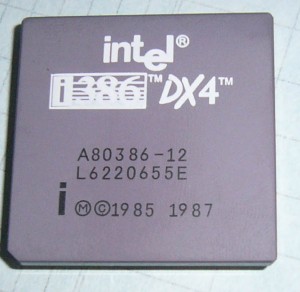
Some counterfeits are easy to spot
As infrastructure ages, and is kept in service well beyond its designed life, and well beyond the life of the IC’s that run it the issue of fakes gets more and more dangerous. Normal manufacturers simply do not make these devices anymore, so brokers fill the gap. Many of which are less then reputable.
Two options exist to help alleviate this. First there is a small few manufacturers who make new legacy components, based on the original masks of the original devices. Rochester Electronics (REI) is perhaps the best known and largest, manufacturing over 20,000 part numbers to OEM spec. Innovasic also makes ASIC based OEM compatible devices.
The second is building a network of authorized distributors. These are distributors that stock IC’s that are no longer made and are trustworthy. The Authorized Directory is a site that allows searching of such distributors as well as news about the counterfeiting problem and what is being done about it.
As collectors counterfeit ICs are hard to deal with. Museums don’t tend to purchase in quantities enough to warrant purchase from large distributors. Collectors do however work together to help find counterfeit IC’s and determine easier ways to spot them.
More Info at Mercury News
September 10th, 2010 ~ by admin
A nice Working Apple 1 computer with much documentation was just (minutes ago) sold on eBay for $22,766.66. Early computers (and the chips that make them work) are greatly increasing in value. Especially if it happens to have the famous Apple name and customizations done by Wozniak himself.
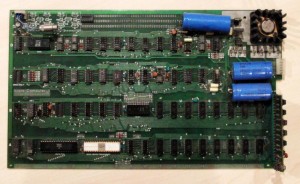
Apple 1 Motherboard
The CPU on this board is a MOS 6502 in a beautiful white ceramic package. It moved 8 bits of data at 1MHz.
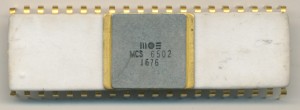
MOS MCS6502 1976
Many other computers from the 1970’s are now worth thousands of dollars as well, such as the IMSAI 8080 and the Kim 1
September 4th, 2010 ~ by admin
iFixit has been doing a series of ‘retro’ teardowns. Looking at various early video game consoles. SO far they have done the following:
All of these systems are pretty interesting designs, however we are going to take a peek at the RCA Studio II. This was RCAs try at the video game console market that was emerging in the 1970s. It sadly was outclassed soon after its introduction by the likes of the Atari 2600 and was discontinued after a mere 2 years. At the heart of the Studio II was a CPU that RCA developed in 1976, a CPU that has outlived the Studio II, and many many other consoles, in fact the RCA COSMAC 1802 (the single chip implementation of the 2 chip 1801) is still made today by Intersil.
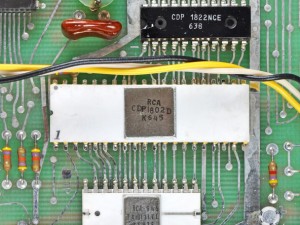
RCA Studio II 1802 Processor - 1976
The 1802 in the console iFixit used is a very uncommon white ceramic package, and is dated 7645, the 1802 was introduced in the first half of 1976 so this is a very early example. The 1802 was one of the first static CMOS designs. It didn’t have a minimum clock frequency so could be sped up/down according to the needs of the design (and power constraints). In the Studio II it ran at 1.7MHz. Other versions ran at 3.2MHz-6.4MHz. One interesting note with the design of the COSMAC was that its frequency responded nearly linearly with supply voltage. At the standard supply of 5V the frequency was 3.2MHz, However, double the supply voltage to 10V and the 1802 would be able to run at 6.4MHz (this only on certain specs of the chip obviously)

Harris CDP1802ACD3 -1992
Today the 1802, due to its flexible 16×16 register design, and well known reliability in harsh environments lives on in dozens of satellites circling the Earth. It was also used as the main computer (6 1802s actually) in the Galileo deep space mission to Jupiter. Many of the CPU’s designed in the 1970s (and often used in video games of the time) still are made (by Intersil now) and used today. THe 1802, 6502, PIC16, and 2901 to name a few. So next time you enjoy the weather report, or watch some satellite TV, its likely that a CPU designed over 35 years ago is being used to get that content to you.











